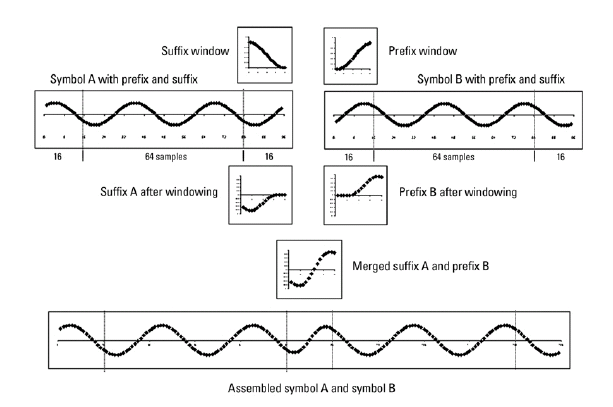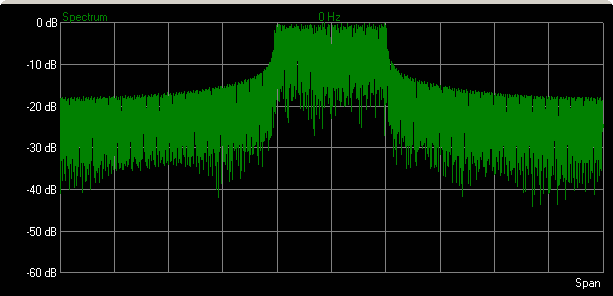
N7617C Signal Studio for WLAN 2026 software calculates one OFDM symbol at a time, using a 64 point IFFT. To create the guard interval at the front of the symbol, it appends the last 16 samples of the 64 point IFFT to the front of the symbol, creating a composite symbol that is 80 samples long. (Refer to the figure below.) Using the last 16 samples has the effect of making the composite symbol appear continuous in time; that is, the 64 point FFT of the symbol will be identical regardless of which 64 samples we choose out of the 80 available. These 16 additional samples are what produce multipath fading immunity since we can slide in time by up to 0.8 ms without causing a decoding error.
We need a means of assembling consecutive symbols without causing spectral regrowth, which arises from the fact that a given symbol rarely begins with the same amplitude and phase with which the previous symbol ended. To avoid spectral regrowth, we must create a smooth transition between the last sample of one symbol and the first sample of the next symbol. We do this with a combination of two tools: a cyclic suffix, and windowing.
To illustrate this, assume we have selected a window length of 16. To create the cyclic suffix, we append the first 16 samples of a given symbol to the end of that symbol, so that now the symbol is effectively 96 samples long. This has the desired effect of making the symbol appear continuous going into the transition. However, if we are to comply with the 802.11g standard, we cannot arbitrarily lengthen the symbol in this way. Instead, this cyclic suffix overlaps in time (and is effectively summed) with the cyclic prefix of the next symbol. This overlapped segment is where windowing is applied. In fact, two windows are applied, one being the mathematical inverse of the other. The first raised cosine window is applied to the cyclic suffix of symbol 1, and rolls off from 1 to 0 over its duration. The second raised cosine window is applied to the cyclic prefix of symbol 2, and rolls on from 0 to1 over its duration. This gives the desired smooth transition from one symbol to the next.
There is one more variable in the equation: the window length. In this example we used a window length of 16, so the cyclic suffix was 16 samples long. However, the length of the cyclic suffix is adjusted along with the window length setting, so any suffix length between 1 and 16 may be set. The effect of windowing is that it improves spectral regrowth, but at the expense of multipath fading immunity. This occurs because redundancy in the guard band is reduced due to the fact that the guard band sample values are compromised by the smoothing.
The following figures display the application of raised cosine windowing.

Figure 1. Root raised cosine windowing

Figure 2. Spectrum plot of I/Q waveform with Windowing Length = 0 samples (no windowing)

Figure 3. Spectrum plot of I/Q waveform with Windowing Length = 16 samples (maximum)